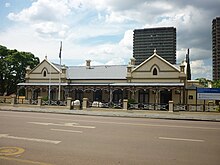Kruger House
The Kruger House ( Afrikaans Krugerhuis ; English Kruger House ) is the former residence of Paul Kruger , a former president of the South African Republic . It is located at 59 WF Nkomo Street (formerly Kerkstraat / Church Street) in Pretoria , South Africa , and is now a museum.
history
The house was planned in 1884 by the architect Tom Claridge and built under the direction of Charles Clark. A special feature is the cement with which the house was built. Because of the poor quality, milk was added to the cement mixture instead of water. In addition, the house was the first in Pretoria to receive an electricity connection so that it could be equipped with electric light. In 1891 the Krugerhaus was connected to the telephone network. Kruger's wife Gezina died here during her husband's exile on July 20, 1901. The South African Union government bought the house in 1925 and set up a museum in it in 1934. The original furnishings were supplemented with elements from the same historical period. The house has been a memorial since 1936.
Building the house
On the porch of the house are two stone lions that President Krüger received on the occasion of his 71st birthday on October 10, 1896 from the mine owner Barney Barnato . Inside the house you can see Mrs. Kruger's reception room, the two offices, the guest bedrooms, the dining room, the Kruger family's bedroom, the pantry and the kitchen. However, the president's reception room plays a special role in the house. Paul Kruger received many people in this room. The best known include Cecil Rhodes , Marthinus Theunis Steyn and Barney Barnato. In addition, the morning prayer took place here every day, and every resident of the house had to be present. Even the guard on duty had to stand on the porch to pray. The home organ was played during morning prayer.
The backyard
At the end of the back yard is the president's railroad car. It was used for state visits to Natal and the Orange Free State . When Kruger went into exile in Europe, this car served as a residence on the trip to Lourenco Marques .
The property of the young Kruger is shown in an exhibition hall. The state carriage and an ox wagon (Afrikaans: Ossewa ) are on display at the entrance . The state gifts form another part of this exhibition.
The exile hall directly opposite deals with Kruger's trip to Europe, his reception in France and in the Netherlands with Queen Wilhelmina . The last part of the exhibition shows the pictures of the state funeral on December 16, 1904 in Pretoria.
Web links
- The Kruger Museum (English)
Coordinates: 25 ° 44 ′ 48 ″ S , 28 ° 10 ′ 53 ″ E
